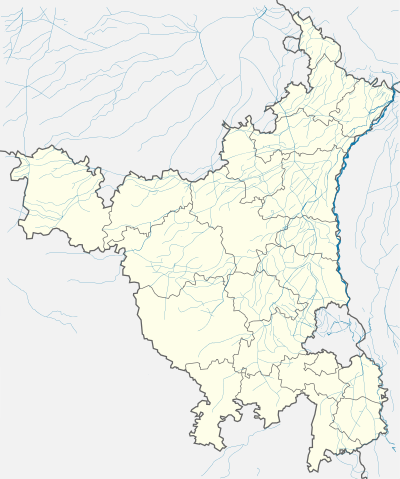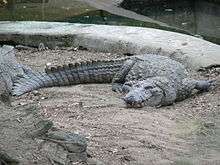Crocodile Breeding Centre, Kurukshetra
| Bhor Saidan Crocodile Breeding Centre भौर सैदां मगरमच्छ प्रजनन केंद्र | |
|---|---|
| Wildlife breeding | |
|
| |
 Bhor Saidan Crocodile Breeding Centre  Bhor Saidan Crocodile Breeding Centre Location in Haryana, India | |
| Coordinates: 29°57′43″N 76°41′49″E / 29.96194°N 76.69694°ECoordinates: 29°57′43″N 76°41′49″E / 29.96194°N 76.69694°E | |
| Country |
|
| State | Haryana |
| District | Kurukshetra district |
| Founded by | Mahant |
| Government | |
| • Type | Government of Haryana |
| • Body | Forests Department, Haryana |
| Languages | |
| • Official | Hindi |
| Time zone | IST (UTC+5:30) |
| Website | www.haryanaforest.gov.in |
The Bhor Saidan Crocodile Breeding Centre (Hindi: भौर सैदां मगरमच्छ प्रजनन केंद्र) is located 22 km from Kurukshetra and 13 km from Thanesar at Bhor Saidan village (Hindi: भौर सैदां), also spelled as Bhour Saidan or Bhoor Saiydan, on the Kurukshetra-Pehowa road near Bhureeshwar Temple, one of the pilgrimage sites in Kurukshetra in the Indian state of Haryana.
Bhor Saidan village was named after Kaurava hero Bhurisrava of Mahabharta, son of Somadutta.[1]
History
The Mugger crocodiles are believed to have been brought by one of the Mahants of the nearby temples in the 1930s. In 1980, Forests Department, Haryana took over the breeding center and the Bhor Saidan village panchayat gave 15+ acre land to the Government of Haryana to start the breeding center.[2] Periphery has been fenced and a mound inside the pond was created to watch the crocodiles from the close range.[3]
Crocodiles At Bhor Saidan
.jpg)

_in_Chabahar%2C_Iran-_by_Hadi_Karimi.jpg)
Center comprises a wild pond that is used to rear Indian Mugger crocodiles (Crocodylus pallustris). The Crocodile Breeding Centre has 10 male, 4 female and 10 young Mugger crocodiles.[4]
Issues
Since crocodiles have 100+ years life-span and breeding center lacks infrastructure to cater for large population of crocodiles, overcrowding is a problem. As a result, caretakers have stopped the external intervention e.g. artificial incubation of the eggs. Though female crocodiles eat the weak youngs and this keeps the population under control.[5]
References
- ↑ Bhor Saidan name history
- ↑ A Review on Status and Conservation of Saltwater Crocodile (Crocodylus porosus) in India
- ↑ Revenue Department of Haryana Govt Gazeteers of Kurukshetra 2009: Chapter I
- ↑ Haryana Samvad June 2012
- ↑ Crocodile boom a ‘gnawing’ problem – by Ruchika M. Khanna, Tribune News Servic30 November 2004

